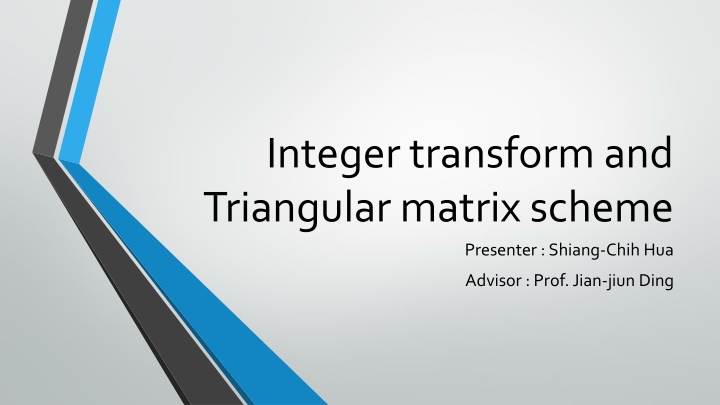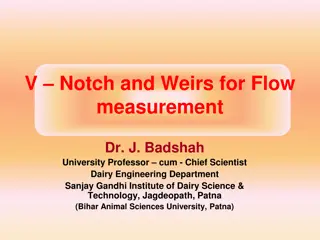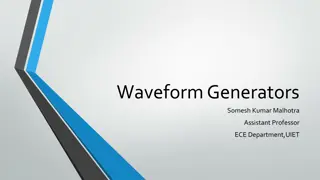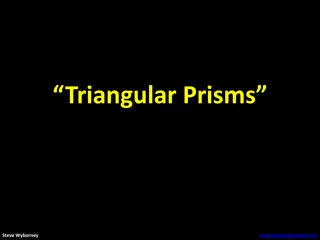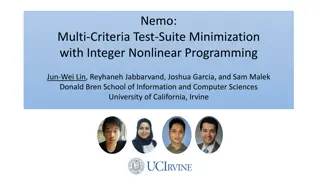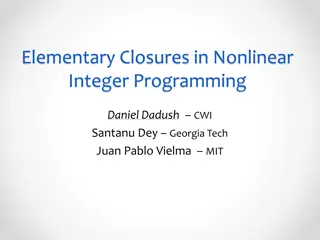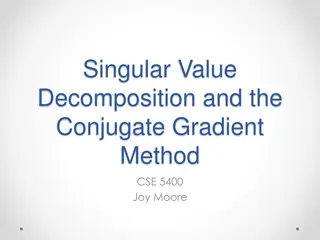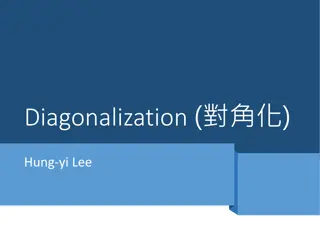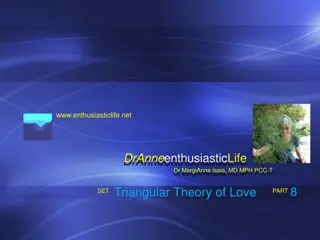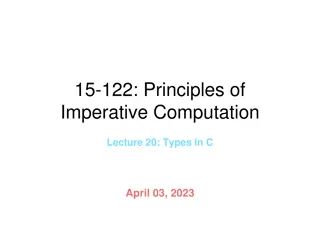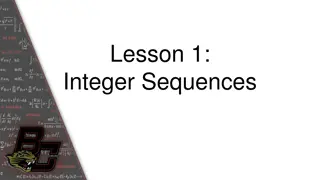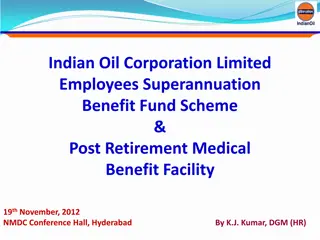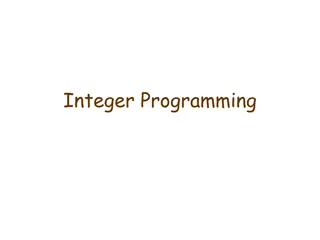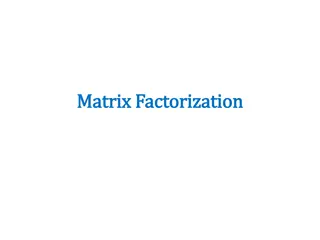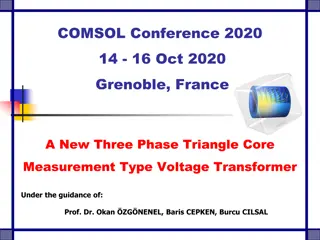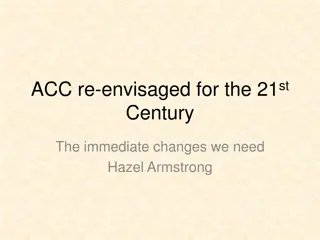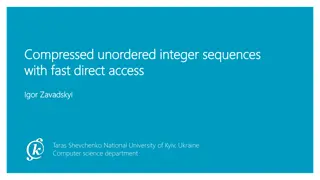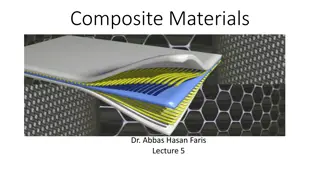Integer Transform and Triangular Matrix Scheme
This research presentation delves into the innovative Integer Transform and Triangular Matrix Scheme, exploring concepts like Truncation, Lifting Scheme, and Improvements of Triangular Matrix Scheme. The study also covers the conversion of non-integer to integer values, advantages of integer transform, and methodologies such as the Walsh transform and DCT. With a focus on efficiency and accuracy, the content discusses the application of integer inputs and outputs, as well as the utilization of truncation and rounding functions in the transform process.
Download Presentation

Please find below an Image/Link to download the presentation.
The content on the website is provided AS IS for your information and personal use only. It may not be sold, licensed, or shared on other websites without obtaining consent from the author.If you encounter any issues during the download, it is possible that the publisher has removed the file from their server.
You are allowed to download the files provided on this website for personal or commercial use, subject to the condition that they are used lawfully. All files are the property of their respective owners.
The content on the website is provided AS IS for your information and personal use only. It may not be sold, licensed, or shared on other websites without obtaining consent from the author.
E N D
Presentation Transcript
Integer transform and Triangular matrix scheme Presenter : Shiang-Chih Hua Advisor : Prof. Jian-jiun Ding
Outline Introduction Truncation Lifting scheme Triangular Matrix Scheme Improvements of Triangular Matrix Scheme
integer & non-integer transform ?1 ?2 ?1 ?2 =5 2 3 integer 7 ? ?? ?? ? ? ? 0.299 0.169 0.5 0.587 0.331 0.419 0.114 0.5 0.081 non-integer =
integer inputs integer outputs integers: 1, 2, 100, -3, 1/8 C x 2^(-b) ?11 ??1 ?1? ???? ? ? = ???= ? 2?, ??? ???? ?,? , 1 ?,? ?
Advantages of integer transform Simple Fast Accuracy
Convert non-integer to integer JPEG-2000 ? = ?+2?+? 4 ,??= ? ?,??= ? ? ? ?? ?? ? ? ? 0.25 0 1 0.5 1 1 0.25 1 0 =
Convert non-integer to integer Walsh transform & DCT 1 1 1 1 1 1 1 1 1 1 1 1 1 1 ? = 1 1
Truncation Rounding function Q, e.g. ? , ? , ? + 0.5 ? ? + ? = ? + ? ? Forward integer transform ? = ?? ? = ? ?? Inverse integer transform ? = ? 1? ? = ? ? 1? ? = ? ? ? , ?
Truncation ? = ? ?? = ?? + ?, ? = ? ? 1? = ? ? 1?? + ? ?, ? 0.5 ? 1? 0.5 ? 0.5 = ? ? + ? 1? = ? + ? ? 1? = ? ? ? 1? ? ? = ? 1? + ? ? 1 ? 1 ??? 1
Truncation ? = ?1 ?2 ?3?, ? = ??? ?1, ?2, ?3 ?11 ?21 ?31 ?12 ?22 ?32 ?13 ?23 ?33 ? 1= , ? 1 = ??? ?11+ ?12+ ?13, ?21+ ?22+ ?23, ?31+ ?32+ ?33
Truncation ??? ? ? ?? ?? ?? ? ?? ? ?? = ??? = ??? ? ?? ?? ??? ??? = ? ? ? ? 1 ?? 1 = 1
Truncation ?11 ?21 ?31 ?12 ?22 ?32 ?13 ?23 ?33 ??? = ?11 ?22 ?33+ ?12 ?23 ?31+ ?13 ?21 ?32 ?11 ?23 ?32 ?12 ?21 ?33 ?13 ?22 ?31 onlypermutation & -1 ???? ?11+ ?12+ ?13 ?21+ ?22+ ?23 ?31+ ?32+ ?33 1
Truncation Triangular matrices are always reversible ?1 ?1 ?1 ?2 ?3 ?1 ?2 ?3 1 ? ? 0 1 ? 0 0 1 ? = ? ??1 + ?2 ? ??1+ ??2 + ?3 ? ??1 + ?2 ? ??1+ ??2 + ?3 , = , =
Goal Given a square matrix A with |det(A)| = 1, find a reversible integer mapping T, such that the error of T(x) Ax is small e.g. ? ? = ? ??? ?? 1? ? ?1? ?1,?2, ,??are reversible integer matrix
Goal Integerization ???= Reversibility ?? 1= ???????? Accuracy Bit Constraint b should be small Less Complexity ? 2? ? 2?, ???= ? 1 ?? ??? ?
Lifting Scheme For 2x2 matrix Degrees of freedom = 4 entries 1 constraint (unit det.) = 3 1 0 1 1 0 1 ? =? ? ? 1 0 ? 1 = ? 1 ? ? 1 ? ? ? = ? ? 1 ??1 + ?2, ?1= ?1+ ? ?? , ?2= ? ? 1 ??1 + ? ?1 ?1 ? 1 ? ? 1 ? ? ?2 ?2 ?
Triangular Matrix Scheme For NxN matrix Degrees of freedom = ?2 1 =1 A = LUS L: lower triangular matrix U: upper triangular matrix S: one row lower triangular matrix 2? ? 1 +1 2? ? 1 + ? 1
Triangular Matrix Scheme ?1,1 ?2,1 ?? 1,1 ??,1 ?1,2 ?2,2 ?? 1,2 ??,2 ?1,? 1 ?1,? 1 ?? 1,? 1 ??,? 1 ?1,? ?2,? ??,? 1 ??,? 1 0 1 0 0 1 0 0 0 1 ?2,1 ?? 1,1 ??,1 ? = , ? = ?? 1,2 ??,2 ??,? 1 1 0 0 0 ?1,2 1 0 0 ?1,? 1 ?1,? 1 1 0 ?1,? ?2,? ??,? 1 1 1 0 0 0 1 0 0 0 1 0 0 0 1 ? = , ? = ??,1 ??,2 ??,? 1
Advantages Systematic ?? 1= ?? Inverse transform is easy ? = ??? ? 1= ? 1? 1? 1 Inverse of integer triangular matrix is still an integer triangular matrix Fast computation Time(L & U) = N + 1
x2 x1 x4 x3 1 0 y1 Q 1 0 y2 Q Q 1 0 y3 Q Q 1 y4 0 Q
Improvements of Triangular Matrix Scheme Decomposition A = LUS, (x1, x2, , xN), (y1, y2, , yN) are not symmetric ? = ?1?1????2?2 D1, D2: diagonal matrix with entries = 2^k P, Q: permutation matrix ? = ?1 Adjust A and apply LUS decomposition ??1 1??2 1?2 ?= ???
Improvements of Triangular Matrix Scheme ? = ?1?1? ?? ?? ??2?2? ? = ?? + ?1?1???1+ ??2+ ?3 Minimize the norm of L & U ? = ?1?1? + 3 ? + 2 ? + 1?2?2 ? ?1?1??? + 3?? + ? 2? + ?? 1?2?2 = ?1?1? ? ??2?2? + ?1 + ?2 + ?3
Further Improvements ? = ?1?1?2?2?3?3?4 ?!4possibilities
Example ? ?? ?? ? ? ? 0.299 0.169 0.5 0.587 0.331 0.419 0.114 0.5 0.081 = 1 2 0 0 173 128 1 0 339 256 0 1 1 0 0 1 0 0 1 0 0 1 0 1 0 1 2 1 0 1 0 0 0 4 0 0 1 ? = 11 256 0 1 4 0 0 0 0 1 11 128 173 256 2 0
Best solution? 20 -10 0 10 ? =10 1, 5 , 1, 4 , , 1,4 No points 0.1 0 10 0 0 0 0.1 10,0 1,0 , 2,0 , , 9,0 , 11,0 , , 19,0 0 10 1 0 1 1 0 10 1 1 0 1 = 0.1 0.1 0 0.1 1 0 1 1 0 0.1 1 1 0 1 = 10 10
Best solution? ?1 ?2 ?1 ?2 =10 0 ?1= 10?1+ ?2 10? 0.1?2 ?2= ? 0.1?2 ?1= ? 0.1?1 ?2= 10?2+ ?1 10? 0.1?1 Yes 0 0.1
Best solution? ? =10 10 0.1 =10 0 1 0 1 1 0 0 0.1 10 0 10 0.1= 1 0 1 1 0 10 1 1 0 1 0.09 0.9 0 0.1 10 1 90 0 1 1 0 0.1 1 1 0 1 = 10 10 10 0.1 10 0 1 0 1 1 0 10 1 0.9 10 0 1 No = 0.1
Reference [1] M. D. Adams, F. Koosentini, R. K. Ward, GeneralizedS Transform, IEEE Trans. Signal Processing, vol. 50, no. 11, pp. 2831-2842, Nov. 2002. [2] S. C. Pei, J. J. Ding, ImprovedReversible Integer Transform, Circuits and Systems, 2006. ISCAS 2006. Proceedings., 2006 IEEE International Symposium on 21-24 May 2006 Page(s):4 pp. 1091-1094. [3] P. Hao, Q. Shi, MatrixFactorizations for Reversible Integer Mapping, IEEE Trans. Signal Processing, vol. 49, pp. 2314-2324, Oct. 2001. [4] S. Oraintara, Y. J. Chen, T. Q. Nguyen, IntegerFast Fourier Transform, IEEE Trans. Signal Processing, pp. 607-618, Mar. 2002.
